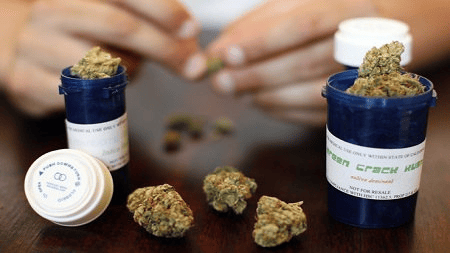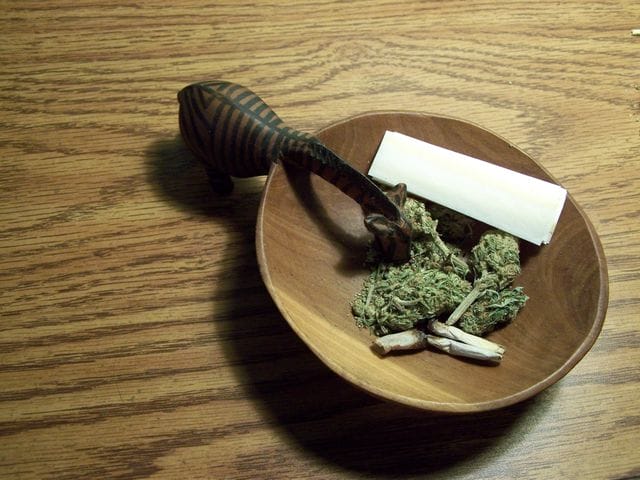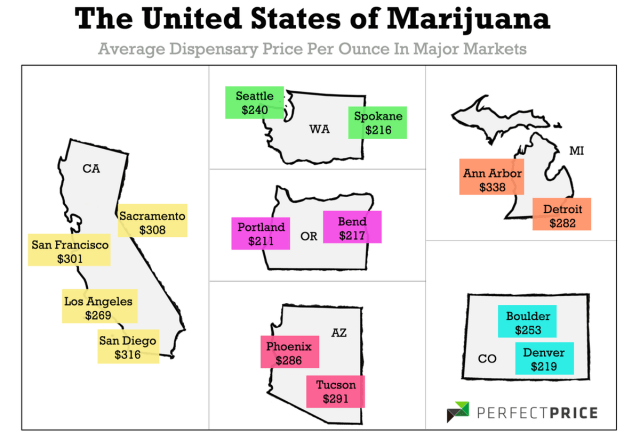
This post is adapted from the blog of Perfect Price, a Priceonomics customer. Does your company have interesting data? Become a Priceonomics customer.
***
Today, there are well over 5,000 marijuana dispensaries across the United States. These dispensaries, which are legal under their respective state laws but not yet condoned by the federal government, come in all shapes and sizes: medicinal or recreational, boutique or chain, brick and mortar or delivery.
Dispensaries also vary on the most important variable: price. Depending on geography, as well as quality, purchasing marijuana can have a wide-ranging impact on your wallet.
In order to understand exactly how much the cost of dispensary marijuana differs, we collected data on prices in the six states with the most dispensaries: Arizona, California, Colorado, Michigan, Oregon, and Washington. This data comes from Perfect Price, a company that tracks prices for groceries, cleaning supplies, and even marijuana.
Overall, Portland and Denver offer the best value among big cities in terms of the average price of an ounce. If smaller cities are included, the marijuana users of Aurora, Colorado, pay the country’s lowest prices, at just $192 an ounce. On the other end of the spectrum, marijuana sold at California and Michigan dispensaries costs 35% more, on average, than it does in Oregon and Colorado.
We also analyzed where consumers might look to the black market. Almost everywhere, black market marijuana is less expensive than what is available legally. But the magnitude of this difference varies. We found that Californians — particularly those in the northern part of the state — and the people of Grand Rapids, Michigan, are those with the largest incentive to look to an illegal dealer.
The Dispensary Market
Marijuana flowers, like those seen in this picture, are the most popularly purchased marijuana product type.
Today, ten states have legal, medical marijuana dispensaries, and two (Colorado and Washington) have dispensaries that sell marijuana for recreational use. The cultivation and sale of legal marijuana is now “big business”, with venture capitalists looking to invest in the mainstream industry. Marijuana sale and possession remains a federal offense, but under the Obama administration, these laws are not enforced.
In order to better understand this burgeoning market, we collected prices from the menus of nearly 6,000 dispensaries.
Our analysis focuses on the price of an ounce of flowers, the unprocessed version of marijuana that is most popular in the United States. To make sure the quality of the marijuana we compared was similar across states, we only analyzed strains of a midlevel quality. Across all dispensaries, the average cost for marijuana in this range is about $260.
The following table displays the average price of an ounce for each of the six major marijuana markets in the United States. Each of these states has over 200 dispensaries.
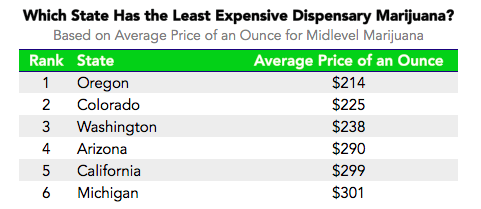
Source: Perfect Price
With an average of $214 for an ounce, Oregon is the state with the least expensive legal marijuana. Although Oregon legalized recreational marijuana in July of 2015, no state-license recreational marijuana dispensaries have finished the registration process. Thus, Oregon’s low prices are fully from medicinal providers. Some researchers believe legalized marijuana in the state might fall below $150 an ounce.
Oregon is followed in affordability by Colorado ($225) and Washington ($238), the two states in which recreational dispensaries are legal. Although initially legal recreational marijuana was quite expensive (often spiking to more than $400 an ounce in 2014), prices have fallen dramatically in the last several years — still, on average, it remains slightly higher than the cost of purchasing medicinal product.
In addition to looking at prices by state, we also examined prices by city in these states. The table below shows the average price for a dispensary ounce in cities with more than 100,000 people. Prices differ substantially across cities—even for those in the same state.
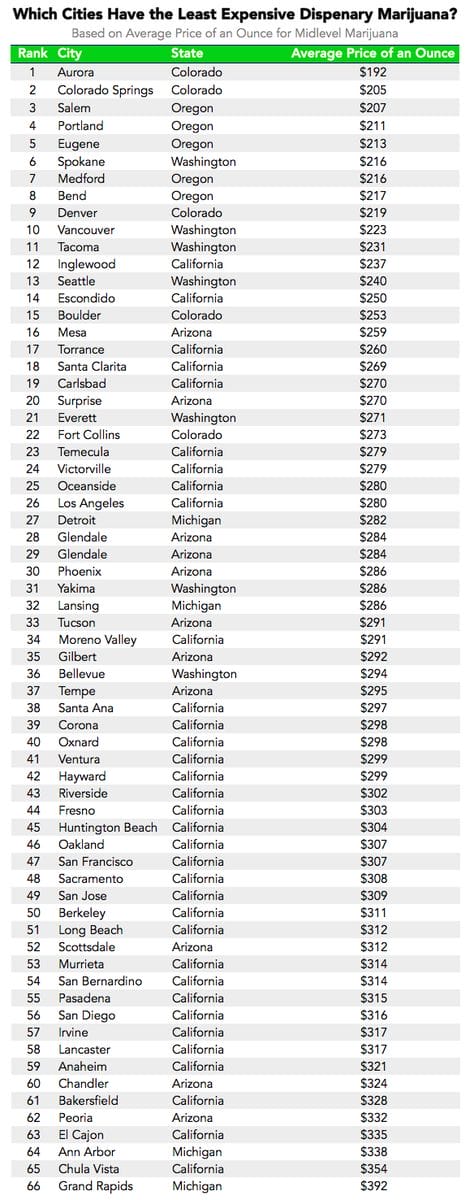
Source: Perfect Price
The city with the least expensive dispensary marijuana in the United States is Aurora, Colorado, at an average price of $192.20. This suburb of Denver is the only market where an ounce of quality marijuana costs less than $200. But if you travel 60 miles north to Fort Collins, Colorado, the average ounce of marijuana will cost you $273.16—an additional $80.
Portland ($211.49) and Denver ($218.69) are vying to be the large city with the least expensive legal marijuana. Among America’s most weed friendly places, dispensaries in these cities face significant competition. We found prices for 378 different dispensaries in Portland and 604 in Denver.
At $392, no city features higher legal marijuana prices than Grand Rapids, Michigan. There are three dispensaries in the city, but only one that sells ounces. The least expensive strain at that dispensary goes for $280, while the majority are $400. It may be worth it for Grand Rapids residents to head to Detroit, where sub-$200 ounces can readily be found.
The Black Market
Black market marijuana is still generally less expensive than legal marijuana.
Even in states where recreational marijuana is legal, the black market remains strong. The government of Colorado (the U.S. state with the most developed recreational marijuana market) estimates that only 60% of marijuana consumed in the state was purchased legally. In California, the legal medicinal cannabis market has over one billion dollars in annual revenues, which is only one third to one fifth of the size of the total market.
If you are willing to disobey the law, there is a financial incentive to head to the black market. Though savings vary by geography, residents in most states can save at least 10% by purchasing marijuana illegally.
Where is the incentive to purchase black market marijuana largest?
We calculated the average price of street marijuana from online websites, and we found that the incentive to hit the black market is greatest in California. By our estimates, buying marijuana on the black market saves consumers 27%—more than double the percentage savings in any other state.

Source: Perfect Price
At 2%, Colorado is the state with the lowest black market savings. There are even cities, like Denver and Aurora, where black market marijuana is more expensive than legal marijuana. Colorado’s government hopes that, due to legalization, the illegal and unregulated market will soon cease to exist.
The price gap between legal and black market marijuana in California is largely driven by huge differences in the northern part of the state. In northern California cities like Sacramento (65%), Oakland (49%), San Jose (45%) and San Francisco (31%), savings from the black market are larger than they are in major cities in the south like Los Angeles (14%) and San Diego (29%). This is primarily driven by the low cost of black market marijuana in the northern part of the state, rather than higher legal prices.
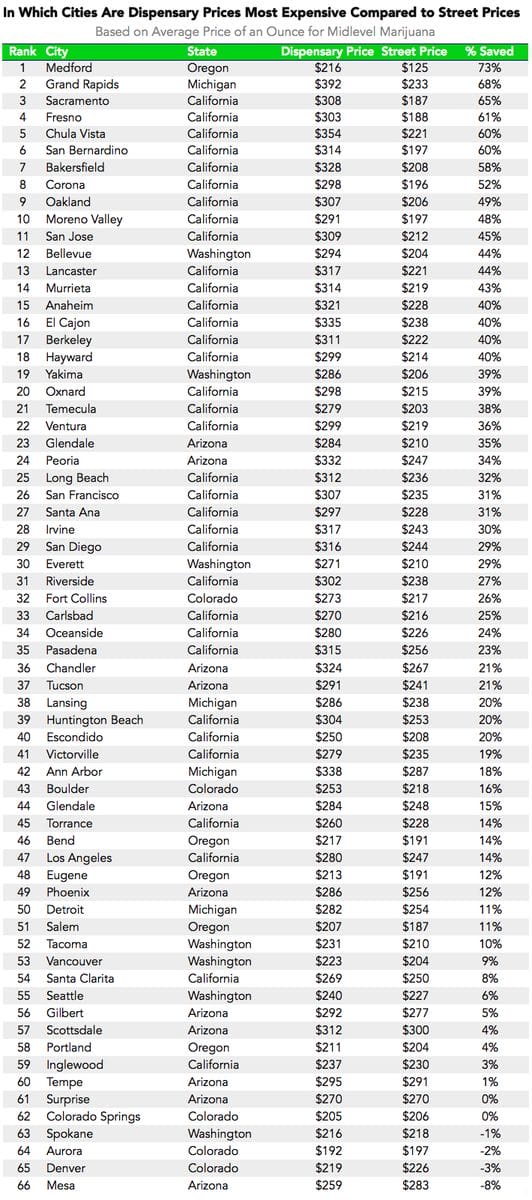
Source: Perfect Price
At 73%, the city with the largest percentage savings is Medford, Oregon. Black market marijuana in Medford sells for only $125, significantly lower than any other city we analyzed. This is likely a result of the large number of marijuana growers in the area.
In terms of absolute dollars, the largest saving are in Grand Rapids, Michigan. On average, buying marijuana on the black market is $160 less expensive in Grand Rapids than buying legally. At about $233 dollars, the black market price for marijuana is close to the $225 average for the cities we analyzed. It is the $392 legal marijuana price that makes for such a huge discrepancy.
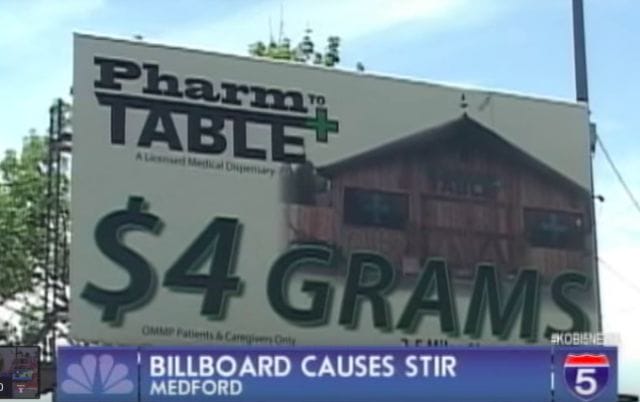
A billboard for a marijuana dispensary in Medford, Oregon. Via YouTube.
Public support for legalizing marijuana increased from a little over a third of Americans to a majority in just the last decade. If current trends persist, more and more states appear likely to legalize medicinal or recreational marijuana, and dispensaries will spread throughout the United States.
As the regulatory environment evolves, and demand expands, changing supplier prices will make for a dynamic market. Dispensaries and retailers will put serious thought into their pricing strategy, and retailers will have to adjust prices in response to changes from suppliers.
Our analysis suggests the prices at those dispensaries will vary substantially, and they won’t be low enough to keep American marijuana users from the black market.
***
For our next post, we explain why “picking the low-hanging fruit” is bullshit — at least, according to actual fruit pickers. To get notified when we post it → join our email list.




